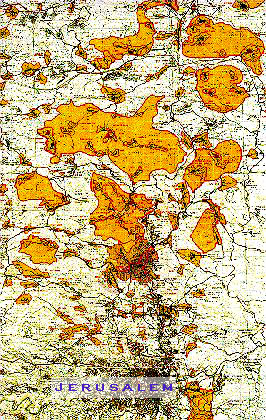
It was only at the beginning of January, one week after redeployment, when I first got hold of a copy of the Oslo 2 map and had a chance to study it in detail. I didn't get them from a research center or press office. They were on sale in Angelos pizza restaurant in Ramallah.
At first glance, they looked like a navigator's map for the Caribbean. The section pictured on the left (the whole map a little too large for my scanner) shows part of the northern West Bank from just below Nablus, at the top, down to Jerusalem, at the bottom.
On this map, a poor to fair reproduction of the officially-issued Oslo 2 map, Area "A" is a light orange colour, while Area "B" is yellow. The only part of Area "A" visible on this section is the Ramallah/Al-Bireh district (roughly central on the map, with the two red lines passing through it).
It is important not to confuse the two areas. Area "A" represents the Palestinian autonomous areas. Area "B" is area under Palestinian administrative control although Israeli retains control of security. Two very different things. The cherry on the cake is that Israel reserves the right of "hot pursuit" into Area "A".
As if that wasn't confusing enough, Area C - i.e. everything else - is under full Israeli sovereignty.
Area A will include (from north to south) Jenin, Tulkaram, Nablus, Jericho, Ramallah/Al-Bireh, Bethlehem/Beit Sahour, and half of Hebron.
The Palestinians now have 1,950 square kilometres of the West Bank and Gaza Strip under various levels of control but Israel, whose settlers in these areas are outnumbered almost 8 to 1, still maintains sovereignty over two-thirds of the land.
Another way of looking at it is that Palestinians maintain full control (excepting airspace, over which they have no control) over the five percent of the West Bank represented by Area "A". In this five percent of the land live 95 percent of the Palestinian population. In other words, Israel just relieved itself of the difficult job of policing the Palestinians of the West Bank and Gaza Strip.

Let's have a closer look. The merged towns of Ramallah and the smaller Al-Bireh are represented by an orange Area "A" at the bottom of the map on the right. The purple triangle with a red border, in the yellow Area B above this, is the police station in Birzeit village. The purple and red triangle on the eastern border of Ramallah is the joint Palestinian-Israeli liason office.
Birzeit University, where I work, is a small distance back down the road from Birzeit towards Ramallah. On the map, it's under the middle "Area 'B'" word, right in the middle of the yellow section, at the node of the mysterious red lines. Do you know what the red lines mean? They're certainly not roads.
With the university and Ramallah in different areas, I forsaw problems. The Gaza Strip, sandwiched on its own between Egypt, Israel, and the sea, is subjected by Israel to economically-devastating punitive closures on a regular basis. What had me worried was Oslo 2's similar defining of separate little territorial units on the West Bank. A huge percentage of the students, staff and faculty live in Ramallah.
Jericho, our first West Bank test case for this theory, after its handover as part of the May 1994 implementation of the "Gaza-Jericho first" deal, had indeed been subsequently closed for a few days here and there. A short time after the northern Area "A" town of Jenin experienced redeployment (before Ramallah), this second test case too had suffered a punitive closure.
I remember expressing these concerns in a Jewish-Arab e-mail dialogue group, Salaam-va-Shalom around this time. Jewish participants flamed me, saying that if I had nothing nice to say I should shut up, and some even told me that I was "anti-peace". I unsubscribed myself from the list.
On 12 February 1996, Ramallah and Birzeit were cut off from each other all day by an Israeli checkpoint. This paralysed the University.
It happened again on 5 March 1996, in the wake of bomb attacks by Palestinian extremists in Jerusalem and Tel Aviv, and university life was cut dead, right up to the time of writing this, on 13 March. This has been one of the sad realities of the peace deal for normal Palestinians.